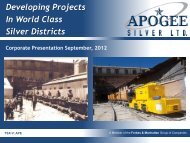Pulacayo Project Feasibility Study - Apogee Silver
Pulacayo Project Feasibility Study - Apogee Silver
Pulacayo Project Feasibility Study - Apogee Silver
Create successful ePaper yourself
Turn your PDF publications into a flip-book with our unique Google optimized e-Paper software.
<strong>Pulacayo</strong> 1 000 t/d Phase I <strong>Feasibility</strong> <strong>Study</strong> - NI 43-101 Technical Report<br />
090644-3-0000-20-IFI-100<br />
20.3 Potential Environmental Impacts and Proposed Mitigation Measures<br />
20.3.1 Water Quality<br />
Within the study area is the water spring called Yanapollera, which has a small dam, and supplies<br />
water to the mining centers of <strong>Pulacayo</strong> and Uyuni. Watersheds of Negro, Huanchaca and<br />
Escalera rivers flow into the plain of Kasapampa following, in most cases, from a north west<br />
direction to south east, these two rivers are considered the largest within the study area.<br />
Water sector bodies have a close relationship between surface and groundwater. Although the<br />
area is dissected by several valleys, some rivers are of perennial type. The water flow in most of<br />
these sources increases in the rainy season, some of them leading to dryness in times of<br />
drought.<br />
For the assessment of water quality, samples were obtained through the certified laboratory<br />
Spectrolab, in charge of collecting the samples.<br />
The sample points for the development of the Environmental Baseline <strong>Study</strong> (ELBA)–Physical,<br />
were collected in dry and wet seasons. The assessment took the standards for defining the<br />
permissible limits from Chart 1-A of the Regulation on Water Pollution (RMCH) of the<br />
Environmental Law 1333, that belongs to the Bolivian regulation.<br />
The results of water quality analysis indicate that the sample with the highest number of nonstandard<br />
parameters (a total of 15) was obtained in the study of the dry season and corresponds<br />
to the tails of the <strong>Pulacayo</strong> Mining Cooperative Ltd. This is because these tails are not treated to<br />
reduce its content of contaminants before coming into contact with the Negro river.<br />
Other samples that stand out for the number of parameters outside the norm are the waters from<br />
tailings in the Kasapampa sector, with a total of 14 physical-chemical and multi-elemental<br />
parameters. This situation is given because in that zone there is tailings accumulation, product of<br />
activities of ore concentration conducted by the <strong>Pulacayo</strong> Works until 1959, these tailings were<br />
washed away by the Negro river flow to be deposited in this zone and contributing to water<br />
contamination mainly associated to heavy metals.<br />
The parameters that are outside the norm, most recurrent in all samples and in all studies are<br />
cadmium, uranium, iron, pH, antimony, arsenic, copper and lead.<br />
20.3.2 Air Quality<br />
Regarding air quality, 6 measurements of particles were performed (PM 10 - PST) at different<br />
points of the <strong>Pulacayo</strong> Mining <strong>Project</strong> area, these points were selected according activities,<br />
locations and regulatory aspects. These measurements were taken both in the dry and wet<br />
season. The results indicate that in almost all the sampled points, the allowable limits for PM 10<br />
and TSP are exceeded.<br />
20.3.3 Soil Quality<br />
To assess the quality of soil a total of 16 samples were collected. The samples were analyzed<br />
and compared between the Environmental Baseline <strong>Study</strong> (ELBA)-Physical ones, for the dry<br />
season and the wet season. Due to the lack of Bolivian bylaws for evaluating soil quality, Medmin<br />
TWP Sudamérica S.A. Av. Encalada 1257 Of. 801, Santiago de Surco Lima 33, Perú (51-1) 4377473<br />
Page 242



